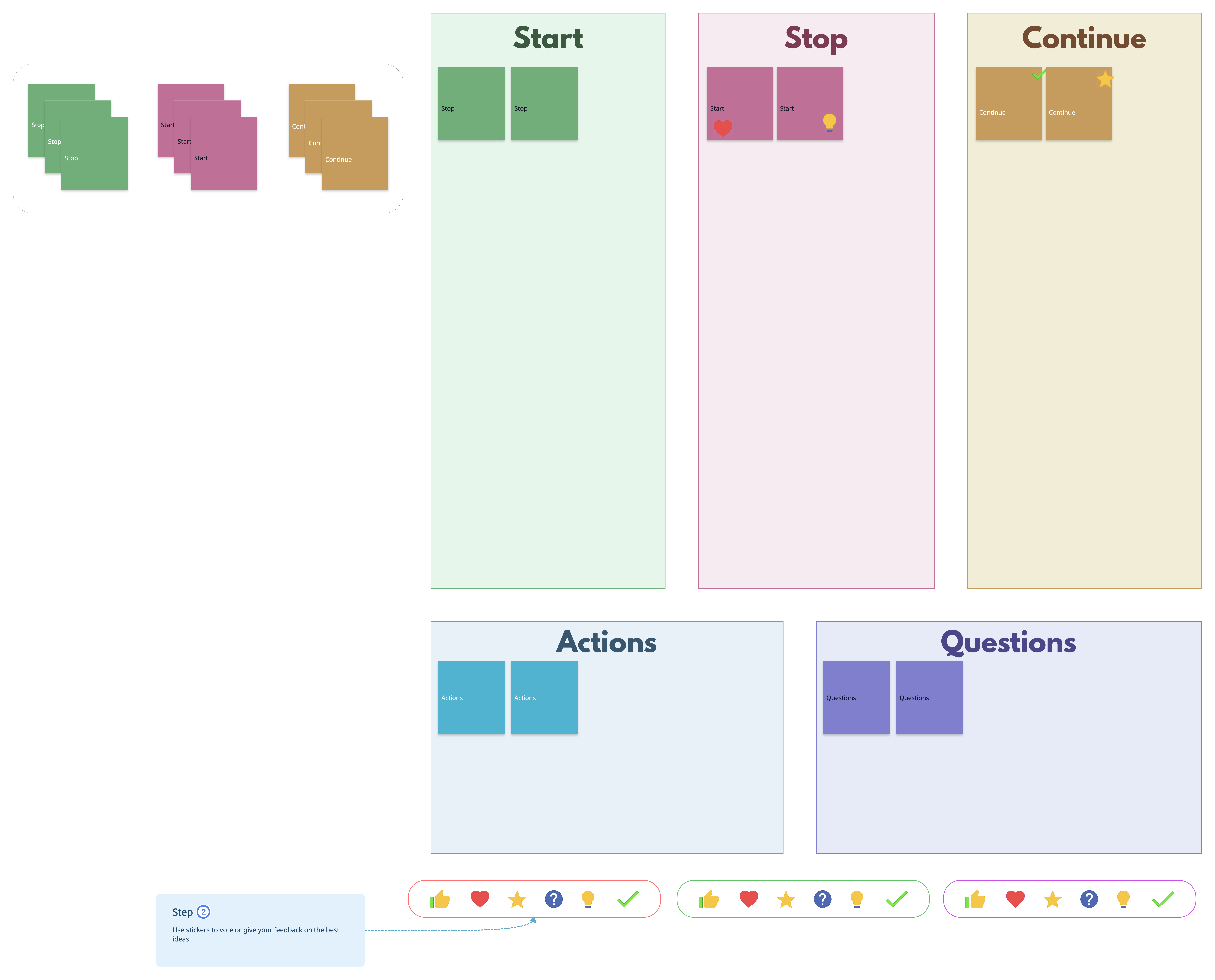The Start Stop Continue exercise is a straightforward way for teams to reflect and improve. It uses a simple three-column format—Start, Stop, and Continue—to help people share ideas on what to begin doing, what to stop, and what’s already working well. Originally popularized in agile teams, it’s now used widely in retrospectives, performance reviews, and team check-ins.
This method encourages open, focused conversations and helps everyone feel heard. It’s especially useful for identifying priorities, clearing up confusion, and making feedback more actionable. Because the structure is easy to follow, it keeps meetings on track and leads to real improvements—not just talk.
Why and When to Use a Start Stop Continue Exercise
The Start Stop Continue exercise fits a variety of team settings where quick, honest feedback is needed. Common use cases include:
- Project retrospectives: Reflect on completed sprints or projects to improve future workflows.
- Process reviews: Review ongoing routines like onboarding or development cycles.
- Team kickoffs or check-ins: Align expectations or check team health.
How often you run it depends on your team’s pace. It works well after milestones, at the end of sprints, or during quarterly reviews—often enough to improve without adding pressure.
How to Run a Start Stop Continue Exercise
Pre-Workshop Setup
- Set a clear goal: Know what you’re focusing on—team performance, product feedback, or process improvement.
- Invite the right people: Include voices from across the team or department for a balanced perspective.
- Choose your space: Book a quiet meeting room or create a virtual space with screen sharing.
- Pick a template: Use Creately’s built-in Start Stop Continue template to save time and keep things structured.
- Share access early: Send out the link before the session so people can log in and test things out.
- Assign roles: A facilitator guides the session, a timekeeper keeps things moving, and a scribe helps document key points.
Running the Exercise
- Brainstorm ideas: Give people 5–7 minutes for each column. Let them add sticky notes—anonymously or with names. One idea per note keeps things clear.
- Group similar items: Spend 10–15 minutes clustering similar thoughts. Combine duplicates and look for patterns.
- Discuss and clarify: Invite people to explain their input. Use colors or icons to highlight urgency or themes.
- Prioritize together: Use an impact vs. effort grid to sort out quick wins and long-term priorities.
- Plan actions: Turn top ideas into tasks. Assign owners, set deadlines, and link them to tools like JIRA or GitHub if needed.
- Collaborate in real time: With Creately, remote team members can edit, comment, and chat live during the session.
Post-Workshop Follow-Up
- Export and share: Download the board as a PDF or CSV and upload it to Confluence or a shared folder.
- Assign responsibility: Make sure everyone knows their action items and due dates. Creately can send reminders too.
- Track progress: Use version history to compare sessions over time and measure improvement.
- Set check-ins: Add a calendar reminder to review progress and update the board regularly.
How to Run the Start Stop Continue Exercise Using AI
Take things a step further by using Creately AI to speed up setup and structure.
Click “Edit Template”: Open the template from Creately’s library, then click the “Edit Template” button. Choose your preferred style.
Type a clear prompt: Describe your session focus, e.g., “Run a Start Stop Continue retrospective for a product launch” or “Reflect on remote team communication.”
Auto-generate your board: Creately AI will instantly generate a complete board with Start, Stop, and Continue columns, suggested items, and space to add your team’s input.
Edit and expand: Add your own ideas or modify AI suggestions. You can also group and prioritize items just like in a manual session.
Use AI to enhance input: The AI can suggest improvements, spot patterns, and even convert notes into actionable tasks.
Tips for Facilitating a Successful Start Stop Continue Exercise
- Create a safe space: Make sure everyone feels comfortable sharing. Set ground rules like no blame, respect all opinions, and focus feedback on actions—not people.
- Set time limits: Timebox each step—brainstorming, grouping, and discussion. Use timers to stay on track and keep the energy up.
- Use visual cues: Color-code sticky notes or add icons to highlight urgency or themes. This makes patterns easier to spot at a glance.
- Involve everyone: Encourage each person to share at least one idea per column. Take turns leading future sessions to keep things balanced.
- Offer anonymous input: Allow anonymous notes so people can share openly. It helps surface honest feedback that might otherwise stay hidden.
Examples of Start Stop Continue Results
1. Improve team collaboration
| Start | Stop | Continue |
| Holding daily 10-minute standups | Scheduling unnecessary meetings | Tracking tasks on a shared board |
| Setting clear meeting agendas | Interrupting during updates | Being transparent about blockers |
| Using shared documentation for decisions | Ignoring action items from previous sessions | Rotating meeting facilitation |
2. Manage projects better
| Start | Stop | Continue |
| Adding time buffers in sprint planning | Overloading team members with tasks | Holding weekly check-ins |
| Using effort vs. impact to prioritize tasks | Skipping sprint reviews | Documenting decisions in one place |
| Reviewing past retros before planning | Rushing QA at the end | Using timelines to keep things visible |
3. Optimizing customer support workflow
| Start | Stop | Continue |
| Sending quick follow-up surveys | Copy-pasting generic replies | Logging recurring issues |
| Creating a knowledge base for FAQs | Ignoring customer sentiment | Personalizing responses when possible |
| Prioritizing tickets by urgency | Handling all support only via email | Sharing learnings with the product team |
Here are more examples of start stop continue to get started
Blank Start Stop Continue Template
Start Stop Continue Example for Remote Teams
Start, Stop, Continue Workspace
Start Stop Continue Example for Teams
Start Stop Continue Example for Managers
How to Analyze and Act on Feedback
Collecting feedback is just the start. To make it meaningful, you need to review, prioritize, and act on what comes out of the session.
- Group and organize: Sort similar ideas into themes. Use visual clusters to spot repeated points and remove duplicates.
- Prioritize effectively: Use an Impact vs. Effort grid to map out quick wins, big projects, and low-priority tasks. Focus your team’s energy where it matters most.
- Assign tasks: Turn top ideas into action items. Assign owners, add deadlines, and link them to tools like JIRA or Asana to keep things moving.
- Share the plan: Export your board or notes as a PDF or spreadsheet to share with stakeholders or store in a shared space for visibility.
- Check in regularly: Set reminders to revisit progress. Regular follow-ups keep tasks on track and allow for updates when needed.
Resources
Use of the ‘Stop, Start, Continue’ method is associated with the production of constructive qualitative feedback by students in higher education | Request PDF. (n.d.). ResearchGate. [online] Available at: https://www.researchgate.net/publication/266642643_Use_of_the_.
Hoon, A., Oliver, E., Szpakowska, K. and Newton, P. (2014). Use of the ‘stop, start, continue’ method is associated with the production of constructive qualitative feedback by students in higher education. Assessment & Evaluation in Higher Education, [online] 40(5), pp.755–767. doi:https://doi.org/10.1080/02602938.2014.956282.
FAQs About the Start Stop Continue Exercise
How long should a Start Stop Continue session last?
Can I run it asynchronously?
How do I keep remote teams engaged?
What’s the difference between SSC and other retrospective formats?
How do I measure the success of the exercise?
What are common start stop continue exercise pitfalls to avoid?
- No follow-up: Action items get forgotten if there’s no accountability.
- Vague feedback: Avoid general comments—make sure input is specific and clear.
- Uneven participation: If only a few people contribute, you’ll miss valuable perspectives.
- Focusing on people, not actions: Keep feedback about behaviors or processes, not individuals.
- Running it too often or too rarely: Use it regularly enough to stay useful, but not so often it feels repetitive.







